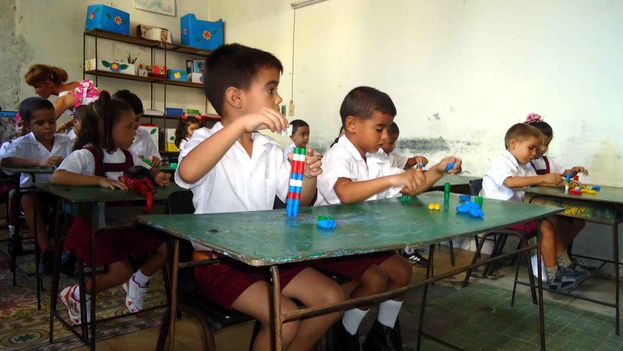
![]() 14ymedio, Havana, 29 August 2016 – The start of the 2016-17 school year in Cuba will be marked by a shortage of teachers. Currently, 94.2% of the teaching positions are filled, without taking into account the use of substitutes, according to comments from Ministry of Education (MINED) authorities at a Saturday meeting with the official press.
14ymedio, Havana, 29 August 2016 – The start of the 2016-17 school year in Cuba will be marked by a shortage of teachers. Currently, 94.2% of the teaching positions are filled, without taking into account the use of substitutes, according to comments from Ministry of Education (MINED) authorities at a Saturday meeting with the official press.
Across the country, some 10,600 schools will receive about 1.7 million students with the start of the new school year on 5 September. However, the sector is now “trawling” for teachers to fill vacant positions, according to to the head of the sector, Ena Elsa Velázquez Cobiella.
Between 13 and 23 August, a MINED team, led by the minister, toured all the provinces and the special municipality of the Isla de la Juventud to review the situation of the schools in each territory.
During the tour a call was made to seek alternative solutions to alleviate the shortage of teachers, for which MINED has mobilized 1,000 young university students hired throughout the country to teach several subjects, especially in primary and junior high schools.
The reinstatement of retired teachers is also one recourse, in the effort to reduce the number of teachers who are “overloaded,” said the minister. Authorities also expect to add more teaching assistants and members of governing boards who will share responsibility in the classroom.
Velázquez Cobiella called for “paying more attention to teachers” to stop the exodus of personnel to other sectors. Organizing industrial and agricultural fairs at times accessible to educators, along with better access to subsidies for home repairs, were some of the proposals to support teachers, “not only in the moral sense but also in the material.”
Without offering global figures that illustrate the shortage of teachers nationwide, industry executives provided some data by territory on Saturday and have called for continuing to improve the quality of education.
Havana is in the worst position with regards to the lack of teachers and during this school year some 2,800 teachers from other provinces need to be moved to Havana to try to alleviate the problem. The teachers will be housed in shelters set up for this purpose.
Despite these emergency solutions, Havana, Mayabeque and Artemisa suffer a deficit of 585 teachers. The situation is particularly serious at the preschool level, where there are a hundred unfilled positions in Havana (77), Mayabeque (19) and Matanzas (4).
Matanzas province also presents a very unfavorable picture, particularly in the main city of Cardenas, as well as in Cienaga de Zapata. There are 137 unfilled positions in this area, according to Raul Hernandez Galarraga, provincial director of Education.
Matanzas schools need about 1,000 professionals to fill teaching vacancies in junior high schools, many of which are occupied temporarily by retired teachers and college students.
The numbers in Ciego de Avila total 663 open positions for education professionals and in Villa Clara the deficit amounts to “more than 1,000 teachers,” according to Director of Education, Esperanza González Barceló.
